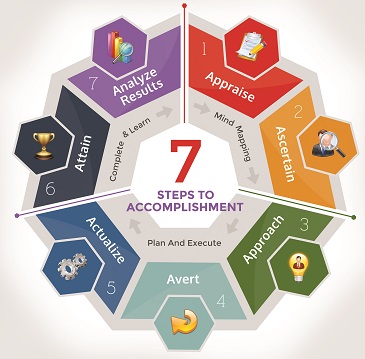Accomplish Your Dreams NOW: The Easy Guide to Setting Goals
Note: Here is the 3rd episode of my ‘Coach Clinton 7-Steps to Accomplishment Methodology’ where I had set the stage for putting you on the track of accomplishment.
To get the most out of this article as well as the ones that will follow, I would suggest you to read the first article and second article before moving forward.
In the 7-step journey towards a successful and satisfying life, the piece that we are going to fit in today is one whose importance cannot be overemphasized.
Do you remember the fable about “The Ant and the Grasshopper”? The ant was diligent and planned for winter by gathering and storing food. What did the grasshopper do? It was short-sighted, only focusing on the present and failed to take heed toward preparation. The ending result? The grasshopper had no food and starved. The moral of the story is best summarized in the old adage – “If you fail to plan, then you plan to fail.”
In the first step, appraise, you saw the importance of evaluating yourself and your performance in order to separate the value-adding habits and patterns from the hazardous ones and then focusing on the actions that will actually help you materialize your accomplishments.
Related Article: It’s Time to View Your Role as a Communication Expert
Moving forward, we will discuss the extremely important step, ascertain, that involves setting up goals for yourself that will drive your accomplishments and help you stay on track until the final objectives are achieved.
Why set goals?
You cannot achieve anything unless and until there is a clear and definite goal in front of you. Having a set of goals in front of you is crucial to your success because you can easily get distracted by other urgent yet unimportant things that won’t contribute towards your accomplishments.
In a landmark research study, American psychologist, Edwin Locke and his colleagues proved the fact that the presence of challenging goals enhances performance as compared to situations where there are easy goals, ambiguous goals or no goals at all. It is of utmost importance to set yourself goals because:
- Goals add clarity to your vision
- Goals help you break overwhelming feats into small, doable tasks
- Goals give you a sense of accomplishment and the motivation to keep moving forward
- Goals provide you feedback on your performance to be used for continuous improvement
- Goals let you weed out the energy parasites from your life and help you focus only on valuable tasks
Elements of effective goals
Edwin Locke also proposed an influential theory by the name of ‘goal setting theory’ that rolls out the 5 basic characteristics of a successful goal(s). The following 5 principles, if kept in view, while setting your goals can improve the chances that a certain goal will be achieved:
- Clarity
- Challenge
- Commitment
- Feedback
- Complexity
There is another framework called the SMART criteria that can help you set successful goals. SMART is the abbreviation of the following parameters that can help you set goals with a higher chance of success:
- Specific
- Measurable
- Achievable
- Realistic
- Time-bound
Based on these two guidelines, you can make sure that your goals will be more likely to yield a successful outcome and contribute towards your life’s bigger ambitions.
Goal Setting Process
Now that there is no room for any doubt left about the importance of goal setting, you need to determine your goals and pursue them religiously if you are interested in living an accomplished and productive life. Since these goals will be deciding your fate, there must be enough due diligence going into the process rather than casually selecting your goals and wasting your time and energy – and having them revised later on.
Based on my extensive experience helping others with their goals, I recommend to use the process laid out here while setting your goals.
Step 1 – Goal Formulation
Remember the self-assessment diagnosis that I explained in my last article? In that article, I introduced you to self-assessment tools like The Innovator’s DNA Assessment, Gallup’s Clifton StrengthsFinder Assessment, Myers-Briggs Type Indicator (MBTI) Personality Inventory and DiSC Personality Test. Using these, and many other similar tools, you need to get to know yourself in greater depth and identify your strengths and weaknesses so that you can leverage your strong points to accelerate your success and find ways to eliminate the shortfalls.
To start with, you will formulate your goals at three levels:
- Long Term / Strategic Goals – First of all, you will sit down and contemplate on the ultimate demands that you want to place on yourself. Through this thinking process, you will visualize what you want to achieve and what you want to become. By doing this, you will be able to construct your long-term goals that will be the guiding light for all your efforts, from this point forward.
- Medium Term Goals – Once the high-level goals are in place, you will have to draw up the supporting goals that will be required to keep you on the right track – a track that leads to the achievement of your strategic goals.
- Short Term Goals – While keeping the ultimate objective(s) in view, you need to devise the short term goals with the intent to break down the sizeable long-term goals into manageable milestones. These goals when duly achieved will take you closer to the fulfillment of your life’s purpose.
Step 2 – Goal Categorization & Prioritization
In the second step, you will categorize all your goals by looking at each one and assigning it an appropriate label. Then you will pick out the themes and make an exhaustive list of all the themes that your goals fall into.
With the category list in front of you, you can assign a priority to each category depending on how much value you give to each one. After assigning a priority to all the categories, you will now have a list of categories or themes which you want to pursue in the shape of goals along with a guideline regarding which one to assign more energies, resources and your precious time.
Step 3 – Monthly Plan Development
Napoleon Hill very rightly said that “A goal is a dream with a deadline”.
Now that you are clear about your goals and their priority, it is time that you develop a monthly plan and convert your goals into monthly deliverables. At the end of each month, you will have to sit down and track your actual progress in the light of your monthly plan. In case you did not meet any deadline, you need to analyze that lapse and uncover the reason behind it so that it won’t happen in future.
Step 4 – Weekly Plan Development
People tend to carry great dreams in their minds throughout their lives, but most of them remain unfulfilled because people are overwhelmed by the sheer size of their wishes and dreams and end up giving up all hope for achieving those dreams. If any objective is broken down into challenging yet reasonable sub-tasks, it becomes easier to believe that you will make it through and finally achieve that goal, no matter how big and ambitious the idea might be.
So starting with the first goal, break it down into tasks/steps and assign weekly completion of tasks for the goal based on your best judgment as to your ability and time to complete. Then stick to the plan and make sure that your weekly objectives are met without fail.
Now you have all you need to start developing, prioritizing and breaking down your goals into smaller tasks. You must take out some quiet time and sit down to cover this tremendously important step. When you are done with your goal development, you will come much closer to the fulfillment of your life’s dreams and aspirations.
Time is very limited and running fast – so take action NOW and get busy chalking out your goals.




